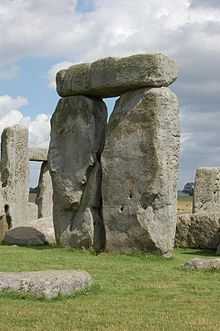Timeline of prehistoric Britain
 Timeline of Prehistoric Britain: Timeline of Prehistoric Britain:  |
| Other centuries |
| Prehistory | 1st century |
Events from the prehistory of Britain (to 1 BC).
Events
- c. 950,000 or 840,000 BC
- Flints worked in south-eastern Britain.[1]
- c. 250,000 BC
- Swanscombe Man (actually a woman), the oldest known human remains in Britain.[2]
- c. 180,000 BC
- c. 26,000 BC
- c. 10,000 BC
- c. 8300 BC
- c. 4000 BC
- c. 3000 BC
- c. 2600 BC
- Main phase of construction at Stonehenge begins, replacing earlier wooden and earthen works.
- c. 2300 BC
- Arrival of the Beaker People in Britain.[2]
- c. 1800 BC
- c. 1600 BC
- c. 1400 BC
- Wessex culture replaced by more agrarian peoples; stone circles and early hillforts produced.[2]
- c. 800 BC
- c. 400 BC
- c. 330 BC
- Pytheas of Massilia circumnavigates Britain.[2]
- c. 300 BC
- La Tene artwork introduced from northern France.[2]
- c. 100 BC
- c. 80 BC
- 55 BC
- Commius, chieftain of the Atrebates, captured by the British after serving as an envoy to Rome.[2]
- 26 August - Julius Caesar lands between Deal and Walmer, wins skirmishes against the British, and frees Commius.[2]
- 31 August - Britons in war-chariots defeat the Romans. Romans return to Gaul.[2]
- 54 BC
- July - Julius Caesar invades Britain and defeats the Catuvellauni under Cassivellaunus.[2]
- September - Tribute fixed, and peace agreed between the Catevellauni and the Trinovantes, allied with Rome. Romans return to Gaul.[2]
- 50 BC
- Fleeing to Britain after a failed revolt in Gaul, Commius becomes chieftain of the Atrebates.[2]
- 34 BC
- Emperor Octavian makes an alliance with the Atrebates and Trinovantes.[2]
- c. 25 BC
- Tincommius, leader of the Atrebates, issues Roman-style coinage.[2]
References
See also